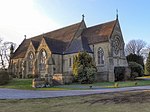Sale is a town in Trafford, Greater Manchester, England, in the historic county of Cheshire on the south bank of the River Mersey, 2 miles (3.2 km) south of Stretford, 3 miles (4.8 km) northeast of Altrincham, and 5 miles (8.0 km) southwest of Manchester. In 2011, it had a population of 134,022, making it the largest town by population in Trafford.Evidence of Stone Age, Roman and Anglo-Saxon activity has previously been discovered locally. In the Middle Ages, Sale was a rural township, linked ecclesiastically with neighbouring Ashton upon Mersey, whose fields and meadows were used for crop and cattle farming. By the 17th century, Sale had a cottage industry manufacturing garthweb, the woven material from which horses' saddle girths were made.
The Bridgewater Canal reached the town in 1765, stimulating Sale's urbanisation. The arrival of the railway in 1849 triggered Sale's growth as an important town and place for people who wanted to travel to and from Manchester, leading to an influx of middle class residents; by the end of the 19th century, the town's population had more than tripled. Agriculture gradually declined as service industries boomed.
Sale's urban growth resulted in a merger with neighbouring Ashton upon Mersey, following the Local Government Act 1929. The increase in population led to the granting of a charter in 1935, giving Sale honorific borough status. Since then, Sale has continued to thrive as one of the main urban centres of Trafford due to its proximity to the M60 motorway and the connections to Manchester and other areas by the Manchester Metrolink network.







